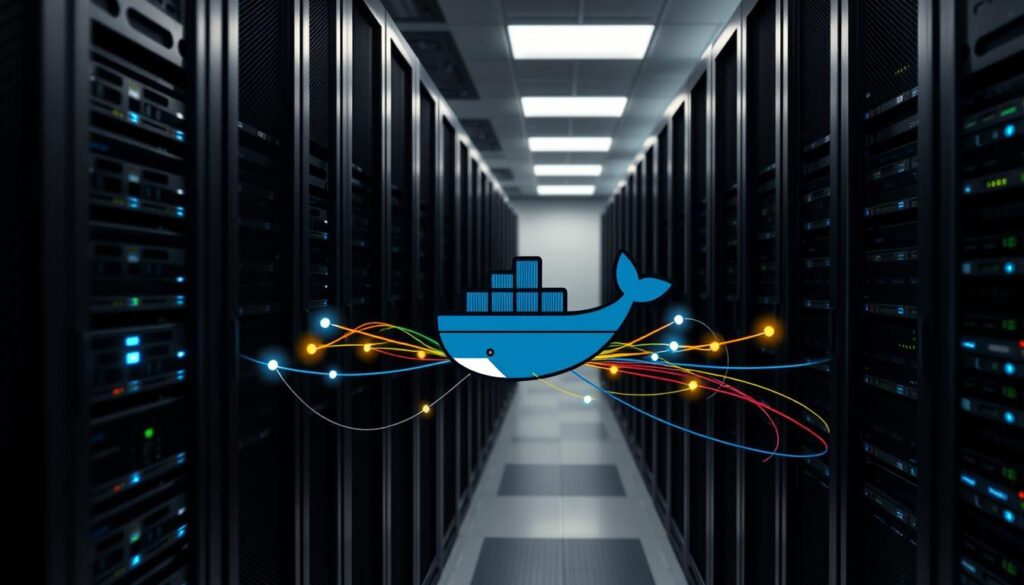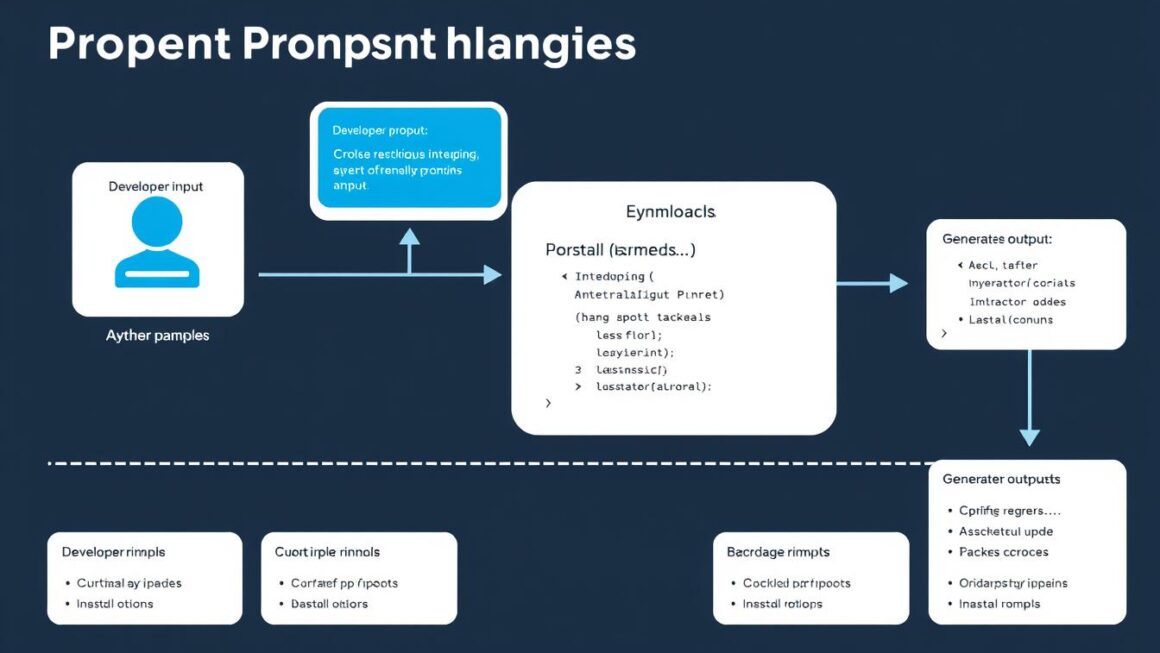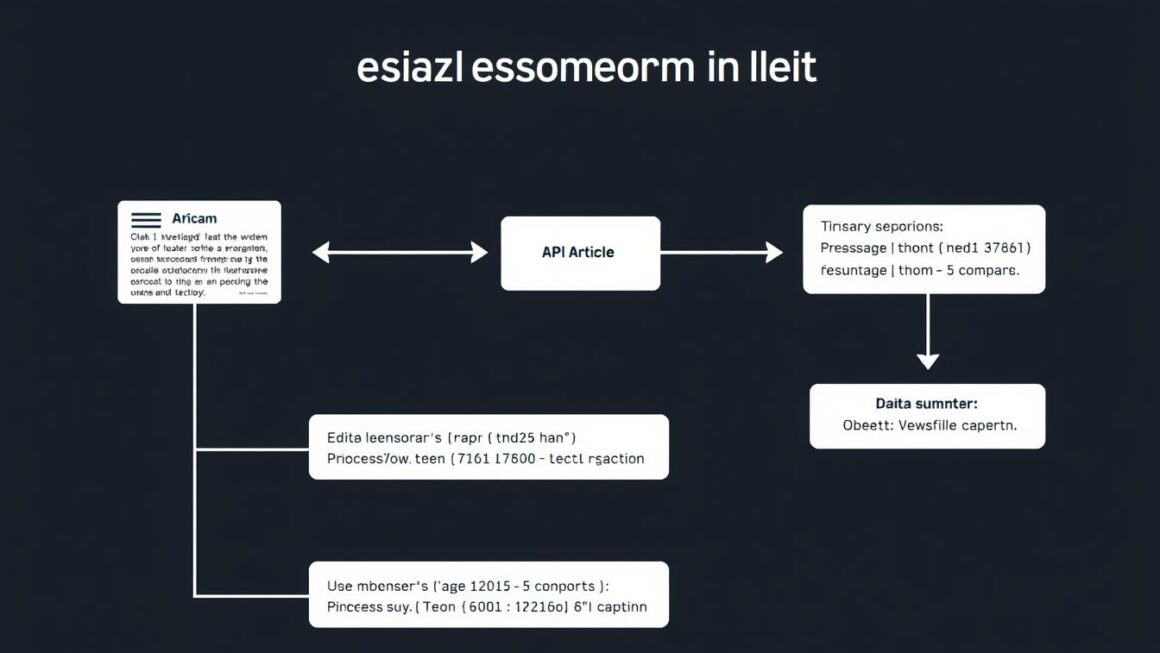Did you know that companies using containerization technologies like Docker have seen a big drop in deployment times? Some have even cut their times in half, up to 70%!
We’re seeing a big change in how apps are made and put out there. Docker has become a key player. It makes deploying apps easier across different places, making it a must-have for DevOps teams.
Docker’s impact on DevOps efficiency is huge. It gives teams a steady and dependable way to put apps out there. This lets teams work better together.
Key Takeaways
- Docker makes deploying apps across different places easier.
- Containerization cuts down deployment times a lot.
- DevOps teams get a lot from Docker’s steady and reliable setup.
- Docker supports complex workflows and high-performance apps.
- Using Docker well can make teams work more efficiently.
Understanding Docker’s Role in Modern DevOps
Docker plays a key role in DevOps, making things more efficient and consistent. It changes how we develop, ship, and deploy apps. Docker is now a must-have in modern DevOps.
The Evolution of Application Deployment
Before, deploying apps was hard because they didn’t work the same everywhere. Docker fixed this by putting apps in containers. These containers have everything needed to run the app, making it work the same everywhere.
This containerization makes deploying apps easier and more reliable. It cuts down on mistakes and makes things more consistent.
Core Concepts of Containerization
Docker’s main idea is to create small, portable containers for apps. These containers have the app and all it needs to run. They use container images, Dockerfiles, and layer caching for quick builds.
Docker also works well with NVIDIA for AI and machine learning. This makes it perfect for these tasks.
How Docker Transforms the DevOps Workflow
Docker changes DevOps by making it consistent and reliable. It lets teams deploy apps the same way everywhere. This means apps work well from start to finish.
This makes the DevOps workflow better. Teams can now make high-quality software faster. Docker’s efficiency and flexibility help a lot.
Docker: Essential Containerization Tool for DevOps
Docker has changed the DevOps world by creating a strong containerization platform. It makes sure portability, scalability, and security are there in all environments and setups.
Key Features That Make Docker Essential
Docker is a must-have for DevOps teams because of its key features. It can make small, portable containers. Docker Scout, a tool with Docker, checks for known security issues and gives fixes, making containers safer.
Docker uses namespaces, cgroups, and union filesystems to create containers. These tools help make a safe space for apps, control resources, and manage images well.
Docker vs. Traditional Virtualization
Docker is different from old virtualization because it runs on the host OS. This makes it lighter and more efficient with system resources.
| Feature | Docker Containerization | Traditional Virtualization |
|---|---|---|
| Resource Usage | Lightweight, shares host OS kernel | Heavyweight, each VM has its own OS |
| Portability | Highly portable across environments | Less portable due to OS dependencies |
| Security | Uses namespaces and cgroups for isolation | VMs provide strong isolation |
The Technical Foundation: Namespaces, cgroups, and Union Filesystems
Docker’s base is namespaces, cgroups, and union filesystems. Namespaces keep containers separate. Cgroups control resources, and union filesystems help manage Docker images.
With these technologies, Docker makes sure apps are deployed right and reliably. This helps with infrastructure automation and makes DevOps work better.
Setting Up Your Docker Environment
Starting your Docker journey means setting up your environment right. A well-configured Docker environment is essential for efficient DevOps practices.
System Requirements and Prerequisites
Before you install Docker, check if your system meets the requirements. Docker works on Windows, macOS, and Linux. You’ll need a compatible OS, enough RAM, and disk space.
| Operating System | Minimum RAM | Disk Space |
|---|---|---|
| Windows 10/11 | 4GB | 20GB |
| macOS | 4GB | 20GB |
| Linux | 2GB | 20GB |
Step-by-Step Installation Guide
Docker’s installation steps differ by operating system. Here’s how to install it on each supported platform.
Windows Installation
To install Docker on Windows, download Docker Desktop from the Docker website. Just follow the prompts and enable the right features during setup.
macOS Installation
For macOS, get Docker Desktop from the Docker site. Open the .dmg file and follow the setup. Docker will be ready to use after installation.
Linux Installation
On Linux, you’ll use the terminal for installation. For example, on Ubuntu, use: sudo apt-get update && sudo apt-get install docker.io. The docker init command helps with Dockerfiles and docker-compose files.
Verifying Your Installation
After installing, check if Docker works by typing docker --version in your terminal. This should show the Docker version you have.
With Docker installed, you’re all set to dive into its features. Proper setup is vital for a smooth Docker experience.
Mastering the Docker CLI
To get the most out of Docker, learning the Docker CLI is key. The Docker Command-Line Interface (CLI) is a powerful tool. It helps us manage containers, images, and networks well.
Essential Docker Commands
The Docker CLI has many commands that are vital for managing Docker resources. Some important ones include:
- docker ps: Lists running containers.
- docker images: Displays available images.
- docker pull: Pulls an image from Docker Hub.
- docker run: Runs a new container from an image.
Managing the Docker Daemon
The Docker daemon manages the lifecycle of containers in the background. We can control the Docker daemon with these commands:
- docker info: Displays system-wide information about Docker.
- docker events: Streams real-time events from the Docker daemon.
Practical Command Examples
Here are some real-world examples of using Docker CLI commands. For example, to run a container from an image, we use:
docker run -d --name my_container nginx
This command starts a new container named “my_container” from the “nginx” image in detached mode.
Troubleshooting Common CLI Issues
When using the Docker CLI, we might face issues like “command not found” or “permission denied.” Here are some common fixes:
| Issue | Solution |
|---|---|
| Command not found | Check if Docker is installed and the PATH variable is set correctly. |
| Permission denied | Run the command with sudo or add the user to the Docker group. |
By learning these Docker CLI commands and troubleshooting tips, we can work more efficiently with Docker.
Working with Docker Images
Docker images are key to containerization. Knowing how to work with them is vital for good DevOps practices. Docker images are like blueprints for containers, and Docker Hub is where you find them.
Understanding Docker Images and Layers
Docker images are made of layers stacked on each other. This layer system is smart because it uses layer caching. This makes building images faster by only updating changed layers. It’s important to know about layers to make your Docker images better.
Finding and Pulling Images from Docker Hub
Docker Hub is a huge place for Docker images to start your container journey. You can search for images on Docker Hub or use the Docker CLI. After finding the right image, you can pull it to your computer with the Docker CLI.
Managing Local Images
Managing local Docker images means listing, inspecting, and removing them when needed. You can use Docker CLI commands to handle your images well. For example, you can list images, check an image’s details, or delete unused ones to save space.
Image Tagging Strategies
Image tagging is very important in Docker image management. Tags help you tell different versions of an image apart. A good image tagging strategy keeps things clear and consistent in your development, testing, and production areas. You can use tags for different builds, releases, or environments.
Building Efficient Docker Images with Dockerfiles
Dockerfiles are key to making Docker images. They help us work more efficiently in software development. Learning to make good Dockerfiles can really improve our workflow.
Dockerfile Syntax and Structure
A Dockerfile is a text file with commands to build an image. It helps make images the same in all environments. The commands are easy to follow, like FROM, RUN, or COPY.
A simple Dockerfile starts with FROM to pick a base image. Then, RUN commands are used to install things.
Optimizing Dockerfiles for Layer Caching
Using layer caching is a big help. Docker saves layers and uses them again if nothing changes. We should list commands from least to most changing. For example, install dependencies first, then copy code.
Multi-stage Builds for Production-Ready Images
Multi-stage builds make images smaller and safer. They let us keep the build and runtime environments separate. We use FROM for each stage and only copy what’s needed to the final image.
Practical Dockerfile Examples
Here’s a simple Dockerfile for a Node.js app:
- Stage 1: Build the app
- Stage 2: Make a production image
| Instruction | Purpose | Example |
|---|---|---|
| FROM | Base Image | FROM node:14 |
| WORKDIR | Set Working Directory | WORKDIR /app |
| COPY | Copy Files | COPY package*.json ./ |
| RUN | Execute Commands | RUN npm install |
By following these tips and using Docker BuildKit, we can make our Docker image creation better. This includes managing secrets.
Running and Managing Docker Containers
Managing Docker containers well is essential for getting the most out of containerization. Containers are a light and easy way to run apps. They make sure apps work the same everywhere.
Container Lifecycle Management
Knowing how Docker containers work is important. You need to create, run, pause, and stop them. Docker has commands to help manage these steps.
Runtime Configuration Options
Docker lets you customize how containers run. You can set environment variables, map ports, and mount volumes. This makes containers fit what apps need.
Resource Constraints and Performance Tuning
Docker helps make containers run better by setting limits on resources like CPU and memory. This ensures containers use host resources wisely.
Debugging Container Issues
Docker has tools and ways to fix problems in containers. You can use logs and interactive shells to find and fix issues.
| Docker Command | Description | Example |
|---|---|---|
| docker run | Run a command in a new container | docker run -it ubuntu /bin/bash |
| docker ps | List running containers | docker ps -a |
| docker logs | Fetch the logs of a container | docker logs -f container_id |
Learning how to manage Docker containers well helps apps run smoothly and efficiently.
Implementing Data Persistence with Docker Volumes
Data persistence is key for many apps, and Docker volumes are a great solution. They keep data safe even when containers restart. This is vital for apps that need to remember their state.
Understanding Docker Storage Options
Docker has several ways to store data, like volumes, bind mounts, and tmpfs mounts. Volumes are best for keeping data safe in Docker containers. They’re fully managed by Docker and make data management easy.
Creating and Managing Volumes
Creating a Docker volume is easy. Just use the Docker CLI command: docker volume create my_volume. To check a volume, use docker volume inspect my_volume. This shows all the volume’s details.
Volume Mounts vs. Bind Mounts
Both volume mounts and bind mounts let us add data to a container. But they’re used differently. Bind mounts rely on the host’s filesystem, while volumes are Docker-managed. Volumes are more flexible and portable.
Data Backup and Recovery Strategies
It’s important to have backup and recovery plans for data. We can back up Docker volumes by making a tar archive of their contents. Regular backups help ensure data is safe in case of problems or data loss.
Configuring Docker Networking

In DevOps, Docker networking is key for container interaction. Docker’s network system lets containers talk to each other and the host machine.
Docker Network Types and Use Cases
Docker has different network types for various needs. The bridge network is the default for standalone containers, keeping them safe and separate. The host network lets containers share the host’s network, removing isolation. For talking between hosts, overlay networks are used, making it possible for containers on different hosts to connect.
Creating Custom Networks
Creating custom networks gives us more control over how containers talk. We can make a network with the Docker CLI, choosing the network driver and options. For example, making an overlay network for a swarm service needs the `–attachable` flag for standalone containers to join.
Container Communication Patterns
Containers can talk to each other if they’re on the same network. Docker offers ways for containers to find and talk to each other, like using names or service names in Docker Compose.
Network Security Best Practices
Keeping Docker networks secure is vital. Best practices include using user-defined networks for communication, encrypting data, and limiting Docker daemon exposure. It’s also important to regularly check and update network settings for security.
By mastering Docker networking, we can make sure our container apps are both efficient and safe.
Streamlining Multi-Container Applications with Docker Compose
Docker Compose makes it easier to manage multi-container apps. It’s a tool that lets you define and run complex Docker apps with one file. This makes handling big application stacks simple.
Docker Compose File Structure
The core of Docker Compose is its docker-compose.yml file. This YAML file outlines services, networks, and volumes for your app. A clear docker-compose.yml is key for smooth app management.
Key elements of the Docker Compose file include:
- Services: Define the containers that make up the application.
- Networks: Configure the networking for the application.
- Volumes: Manage persistent data for the application.
Defining Services, Networks, and Volumes
Services in Docker Compose are defined by the Docker image or build context. Networks help services talk to each other or stay separate. Volumes keep data safe even when the app stops.
Managing Application Stacks
Docker Compose makes managing big app stacks easy. With docker-compose up and docker-compose down, starting and stopping your app is a breeze.
Development vs. Production Configurations
Docker Compose supports different setups for dev and prod. You can use multiple Compose files or tweak settings for each environment.
| Environment | Configuration Considerations |
|---|---|
| Development | Mount source code as volumes for live updates, use docker-compose watch for automated reloads. |
| Production | Use pre-built images, configure for scalability and high availability. |
Using Docker Compose makes managing multi-container apps much easier. It’s a must-have for modern DevOps.
Distributing Docker Images with Container Registries
Getting Docker images out there is key for smooth DevOps work. Container registries are vital for managing and sharing Docker images.
Working with Docker Hub
Docker Hub is a top spot for Docker images, with a huge collection of public images. Docker Hub makes it easy to find and share images, a big deal in the Docker world.
Setting Up Private Registries
For private or sensitive images, private registries are a must. Setting one up means setting up the registry, managing who can access it, and keeping it secure.
Image Distribution Workflows
Image distribution workflows include building, tagging, and pushing images to registries. Efficient workflows are key for automating image distribution. This ensures images are reliably deployed everywhere.
Registry Authentication and Security
Keeping container registries safe is essential. This means using things like role-based access control (RBAC) and making sure images are signed and checked. Docker image signing is vital for keeping containers secure.
Implementing Microservices Architecture with Docker

Docker makes microservices architecture easier, leading to faster development. Its lightweight and portable nature is perfect for microservices. It ensures efficient service isolation and makes deployment smoother.
Docker’s Role in Microservices
Docker is key in microservices, providing a containerization platform. It packages each service with its dependencies, ensuring consistency. This boosts DevOps efficiency by reducing service conflicts.
Service Isolation and Communication
Service isolation is a big plus with Docker for microservices. Containers are isolated but can talk to each other through Docker’s networking. This means one service’s problems won’t harm others.
Deployment Patterns for Microservices
Docker supports many deployment patterns for microservices, like blue-green and canary releases. These patterns help teams follow continuous delivery practices. They lower the risk of new service versions.
Monitoring and Troubleshooting Microservices
Monitoring and fixing microservices with Docker uses tools that collect logs and metrics from containers. This is key for keeping microservices healthy and running well in a DevOps setup.
Using Docker for microservices architecture helps organizations scale, be resilient, and flexible. It fits well with modern DevOps practices.
Integrating Docker into CI/CD Pipelines
Using Docker in CI/CD pipelines boosts automation, efficiency, and consistency. It works well with CI/CD tools, making it a top choice for automation.
Docker-Based CI/CD Workflows
Docker-based CI/CD workflows create a consistent environment for app development, testing, and deployment. Docker’s containerization makes sure apps work the same everywhere.
Automating Builds and Tests
Docker makes automating builds and tests easier with a consistent environment. Docker BuildKit adds advanced features for building Docker images, improving the build process.
| Feature | Docker | Traditional Virtualization |
|---|---|---|
| Environment Consistency | High | Variable |
| Resource Usage | Low | High |
| Deployment Speed | Fast | Slow |
Deployment Strategies with Docker
Docker supports various deployment strategies like blue-green deployments and canary releases. This helps manage risk and ensures apps are always available.
Real-World CI/CD Pipeline Examples
Many companies have added Docker to their CI/CD pipelines. They’ve seen big improvements in how often they deploy and how reliable their deployments are.
Scaling with Docker Orchestration Tools
Exploring containerization shows us how vital Docker orchestration tools are for scaling apps. Orchestration is key to managing containerized apps, vital in big deployments.
Introduction to Container Orchestration
Container orchestration automates deploying, scaling, and managing containers. Docker’s tools are essential for apps to run well across various environments. Docker’s orchestration capabilities let developers focus on coding, not infrastructure.
Docker Swarm for Simple Orchestration
Docker Swarm is a simple tool for managing Docker nodes. It’s great for small to medium projects or teams already using Docker.
Kubernetes Integration with Docker
Kubernetes is a powerful tool that works well with Docker. It has advanced features for automating app deployment and scaling. Kubernetes is best for big, complex apps and is popular in the enterprise.
| Feature | Docker Swarm | Kubernetes |
|---|---|---|
| Complexity | Simple, easy to use | Complex, feature-rich |
| Scalability | Suitable for small to medium deployments | Ideal for large-scale, complex deployments |
| Integration | Tight integration with Docker | Supports multiple container runtimes |
Choosing the Right Orchestration Solution
Choosing between Docker Swarm and Kubernetes depends on your app’s complexity and scale. Docker Swarm is good for simple apps or those in the Docker ecosystem. But for complex or large apps, Kubernetes is better due to its advanced features and scalability.
In summary, Docker orchestration tools are key for scaling apps efficiently. Knowing about Docker Swarm and Kubernetes helps developers choose the right DevOps solution for their needs.
Conclusion: Harnessing Docker for DevOps Excellence
Docker has changed how we do DevOps, making it easier to deploy apps and grow them. We’ve looked at how Docker is key in modern DevOps, from its basics to how it fits into CI/CD pipelines.
Using Docker helps us reach DevOps excellence. It lets us put apps in containers that work the same everywhere. This makes teamwork better, cuts down on deployment times, and boosts efficiency.
Docker’s impact on DevOps is wide-ranging. It helps with complex apps and scaling, giving us a full solution for software development. With Docker, we can innovate, keep things secure, and excel in DevOps.
In short, Docker is essential for any team wanting to boost DevOps efficiency. By using Docker, we can make our work easier, grow our projects, and succeed in business.



